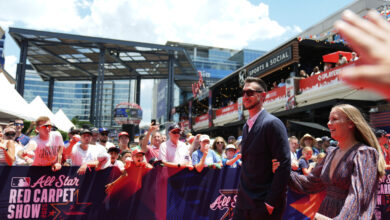
Cubs Need to Lean into Retro Baseball Strategy to Maximize Talent
Small ball. Hit-and-run. Station-to-station offense. Stealing bases. Prioritizing fundamental defense. Sounds like the kind of strategy teams would have employed through the 1980s, but you hardly see modern organizations performing with more than a cursory nod to these nostalgic concepts. Even if we can agree that defense is always in style, it’s not often you’ll find a team willingly sacrificing offense in order to gain an edge in outs above average.
The Cubs appear to be an exception to the rule, however, as they’ve bet heavily on improved defense and a pitch-to-contact staff to anchor their rebuild. That certainly didn’t seem to be the plan heading into the offseason, when Jed Hoyer spoke of wanting to remove as much luck as possible from games by scoring enough runs to blow opponents out. For whatever reason, and you’ll be spared a redux since we’ve gone over lots of them already this offseason, it turns out run prevention is the plan.
Nico Hoerner moving to the right side of the diamond, where he generated a great deal more relative value last season, should have the most obvious impact in that regard. Not only is Hoerner a huge improvement over the rotating cast of keystone characters from 2022, but the new shift limitations will place even more emphasis on defensive prowess at second base.
Cody Bellinger likewise provides a huge boost over a center field unit that graded out as the worst in baseball according to more than one data point. Add in Dansby Swanson and a catcher combo of Yan Gomes and Tucker Barnhart and you’ve got the makings of an old-school defense-first alignment up the middle. Ian Happ has a Gold Glove in left, Seiya Suzuki should improve in right, and the combination of Eric Hosmer and Trey Mancini at first could be solid.
Yes, I am aware that Hosmer’s recent performance isn’t in keeping with a reputation based on four Gold Gloves. The other corner infield spot is a little dicey as well, with both Patrick Wisdom and Christopher Morel coming off of forgettable defensive efforts at third. Wisdom was tremendous in ’21, though, and Morel has the arm and athleticism to excel if he’s able to play within himself.
But enough about defense, which has been among the most oft-discussed aspects of this Cubs team over the last several weeks. What I want to touch on now is how Bellinger and Hoerner — both of whom could actually end up hitting better than their predecessors — are excellent baserunners on a roster that should be even more aggressive on the basepaths this year.
As Tommy Meyers pointed out, the Cubs were fourth in MLB last season with 111 steals. That total is their highest since 2006 (121) and is one of only eight times they’ve stolen 100 or more bases since 1990, plus it represents a huge jump from the two previous full seasons. The Cubs had 86 steals in 2021 and just 45 in ’19, a tally that ranked 29th in the majors (Twins – 28).
The Cubs were 4th in the majors in steals (and attempts) last year. They added Swanson (18) and Bellinger (14).
With rule changes and still a potential lack of thump in the lineup, I wonder if see Cubs get even more aggressive on the basepaths this year.
— FullCountTommy (@FullCountTommy) February 13, 2023
Hoerner led the team with 20 steals and a number of factors indicate that number should increase this season. In addition to possibly serving as the leadoff hitter — you’d love to see a more patient approach for that to work — the bases are larger and there are limits on how often pitchers can disengage with the rubber. Swanson could find himself swiping 20 or more bags and Bellinger could break his current career-best mark of 15.
More than just the rule changes opening the door to a somewhat forgotten art, the Cubs should be stealing more bases simply because they have to find ways to score runs in spite of their lack of power. The hit-and-run should also be in play more often for that same reason.
While the Cubs were second-best in the majors and going first-to-third on singles last year (102 times), they ranked 24th when it came to scoring from first on a double (24). They were 27th in baseball at scoring from second on a double (84), so you can see how getting a few extra steps would boost their overall production. And lest you go thinking this is just a matter of the Cubs not hitting many doubles, their 265 two-base hits ranked 15th in MLB.
All told, the Cubs were tied for seventh in XBT%, which is the frequency with which runners advanced more than one base on a single or more than two bases on a double. Their 44% mark was just six points shy of the Braves for best in the game and eight points better than the Giants for worst, so you can see how just a few plays could end up making a difference.
I had been begging the Cubs to get more aggressive on the bases for the past few seasons, to find ways to jump-start the offense that broke somewhere along the lines and was never fixed. Now it appears they’ve taken the message to heart, though I suspect my whining didn’t actually catalyze their changes. Given what we know about how this roster is built and what it must do to compete in a meaningful way, I imagine we’re going to see some retro baseball at Wrigley this summer.
Should be fun.

